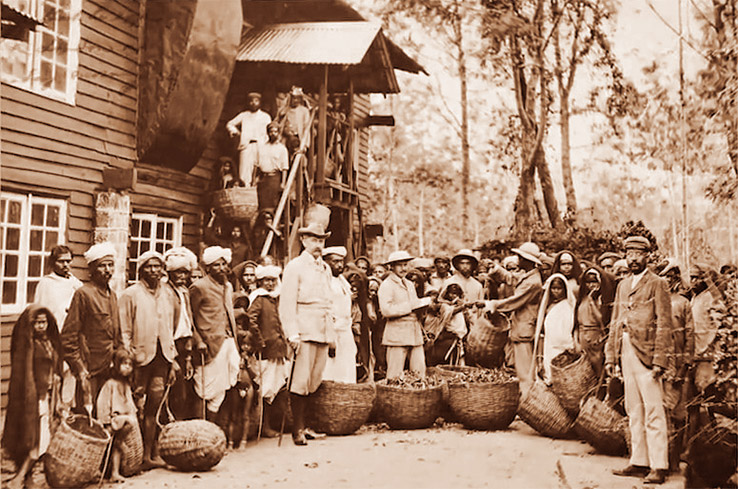 James Taylor is widely recognized as the 'pioneer' of Ceylon Tea. Originally from Scotland, he arrived on the island in 1852. Assigned to manage the Loolecondera Estate, a coffee plantation in the Kandy District, he quickly rose to the position of manager within five years. By 1860, Ceylon had become the world's largest coffee producer. However, the owners of Loolecondera advised Taylor to explore the cultivation of tea. This decision proved to be fortunate, as the coffee rust disease emerged two years later, leading to the near extinction of coffee within the next two decades.
James Taylor is widely recognized as the 'pioneer' of Ceylon Tea. Originally from Scotland, he arrived on the island in 1852. Assigned to manage the Loolecondera Estate, a coffee plantation in the Kandy District, he quickly rose to the position of manager within five years. By 1860, Ceylon had become the world's largest coffee producer. However, the owners of Loolecondera advised Taylor to explore the cultivation of tea. This decision proved to be fortunate, as the coffee rust disease emerged two years later, leading to the near extinction of coffee within the next two decades.
In 1866, under the direction of G.D.B. Harrison, the owner of Loolecondera Estate, Hewaheta, Taylor (alongside W.M. Leake) obtained tea seeds from the Peradeniya Botanical Gardens and planted them along the estate's roadsides. This initiative aimed to compensate for the losses incurred by the declining coffee plantations. Successfully, within a year, the first tea estate, Field No. 7, was established on the Loolecondera Estate, expanding to 19 acres and marking the inception of the tea industry.
Subsequently, Taylor initiated the operation of a full-fledged tea factory at the Loolecondera Estate, with the first sale of Loolecondera tea taking place in Kandy in 1872. The initial sale comprised two small packs, each containing 23 pounds of tea. The Maskeliya Planter's Association was founded in July of the same year, as the plantation activities evolved into a prosperous commercial venture.
In 1873, the initial shipment of Ceylon tea, weighing 23 pounds or 10 kg, arrived in London for trade. Its value was set at Rs. 58, which was considered significant at that time.
During the same year, Taylor constructed the first Tea House or factory. Made of wattle and daub, it had hessian lofts where the tea leaves were withered. Taylor is credited with inventing a tea leaf roller, powered by a 20ft. water wheel. In 1880, botanist Henry Trimen took over as Director of the Royal Botanical Gardens, Peradeniya, succeeding the renowned George Thwaites. Trimen played a crucial role in the transition from coffee to tea, making his contribution invaluable. The Walker brothers invented the first successful tea-rolling machine in the same year, which was manufactured by their firm, John Walker & Co.
As Ceylon tea gained popularity worldwide, the first public auction took place on July 30, 1883, at the premises of Somerville and Co., located on Queen Street (now renamed Janadhipathi Mawatha). Although the auction had only moderate success, with one lot of Kabaragala un-assorted tea selling for Rs. 45 cents per pound, the other four lots remained unsold due to either lack of bids or bids that did not meet the Broker's expectations. The Colombo Tea Auction is recognized as the oldest and largest tea auction center globally. Despite setbacks, Somerville & Co. and other brokers persevered, conducting regular auctions that promoted the interests of both tea buyers and sellers, both locally and internationally.
In 1884, John Walker played a role in constructing the first central tea factory at the Fairyland Estate (Mount Pedro). The factory belonged to J. A. Rossiter.
It is believed that Sir Thomas Lipton visited Ceylon in 1890 and met with James Taylor. In 1891, Taylor received a tea and coffee service from the Planters Association, with an inscription that read, "to James Taylor.

In 1948, our island achieved independence and remains a part of the British Commonwealth. Along with this newfound freedom, an export duty on tea was implemented on October 1, 1951. Subsequently, on June 1, eight years later, the Ad Valorem Tax was introduced for teas sold at Colombo auctions.
By 1960, more than 200,000 hectares of tea estates produced over 200,000 metric tons of tea, establishing Sri Lanka as one of the leading tea exporters globally. Although efforts were made to maintain records of the existing estates and plantations, some information was lost due to the fact that many of them originally cultivated coffee before transitioning to tea.
In 1963, the production and export of Instant Teas were introduced, and by 1965, Sri Lanka had become the world's largest tea exporter for the first time. These achievements can be attributed to the collective efforts of various stakeholders, including plantation workers, tea pickers, auctions, and exporters.
To commemorate 100 years of the tea industry, the first International Tea Convention took place in 1966. Starting from a modest export of only 23 pounds, tea production expanded rapidly, and by the turn of the century, exports had reached 151,000,000 pounds. The reputation of Ceylon tea also soared during this time, as the industry continued to thrive in the 20th century.
Between 1971 and 1972, the Sri Lankan government nationalized and took over privately-owned tea estates to support the industry's growth. In 1976, the Sri Lanka Tea Board was established, along with other bodies such as the Janatha Estate Development Board (JEDB), Sri Lanka State Plantation Corporation (SLSPC), and the Tea Small Holding Development Authority (TSHDA), to oversee the government-acquired estates. The introduction of tea bags for export also occurred during this period.
In 1980, our island became the official tea supplier for the Moscow Summer Olympics. Two years later, the Sri Lankan Tea Board was restructured.